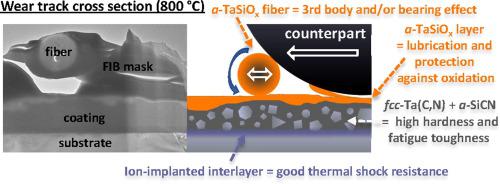当前位置:
X-MOL 学术
›
Appl. Surf. Sci.
›
论文详情
Our official English website, www.x-mol.net, welcomes your feedback! (Note: you will need to create a separate account there.)
Insight into high temperature performance of magnetron sputtered Si–Ta–C–(N) coatings with an ion-implanted interlayer
Applied Surface Science ( IF 6.7 ) Pub Date : 2021-03-01 , DOI: 10.1016/j.apsusc.2020.148526 A.V. Bondarev , M.N. Antonyuk , Ph.V. Kiryukhantsev-Korneev , T. Polcar , D.V. Shtansky
Applied Surface Science ( IF 6.7 ) Pub Date : 2021-03-01 , DOI: 10.1016/j.apsusc.2020.148526 A.V. Bondarev , M.N. Antonyuk , Ph.V. Kiryukhantsev-Korneev , T. Polcar , D.V. Shtansky

|
Abstract Challenges related to the application of wear resistant coatings at high temperatures require the development of novel materials with an exceptional combination of mechanical, chemical and tribological properties. The present paper is focused on understanding of relationships between structure, composition and high-temperature performance of the Si-Ta-C-(N) coatings. The coatings were produced using combined magnetron sputtering (MS) and ion implantation (CMSII) technique. It was found that ion implanted coatings demonstrated better thermal shock resistance compared to MS Si-Ta-C-(N) coatings. The Si-Ta-C-(N) coatings revealed a nanocomposite structure consisting of 2-3 nm fcc Ta(C,N,Si) grains and amorphous a-Si and a-SiC(N) phases. The composition and structure of amorphous matrix strongly affected tribological performance of the Si-Ta-C-(N) coatings. The N-doped coatings exhibited exceptionally good tribological performance due to a higher ductility of N-rich amorphous a-SiCN and a-SiNx matrix, and fcc Ta(C,N)-based crystallites compared with the a-Si+a-SiC, and fcc TaC-based phases in N-free coating. The Si-Ta-C-(N) coatings easily withstood oxidation annealing at 800 °C due to the formation of a 200 nm protective TaSiOx amorphous layer. Oxidation annealings revealed that under thin protective TaSiOx layer crystalline components of coatings did not change when Si and C from the amorphous matrix started to diffuse towards the substrate at 800 °C but even after redistribution of elements and formation of oxide scale the coatings demonstrated reasonably high hardness – 13-16 GPa. Triboactivated formation of TaSiOx fibers which could slide/roll against the same TaSiOx tribolayer during high-temperature tribotests resulted in low coefficient of friction values (0.23 at 800 °C) and absence of wear.
中文翻译:

深入了解具有离子注入夹层的磁控溅射 Si-Ta-C-(N) 涂层的高温性能
摘要 与耐磨涂层在高温下应用相关的挑战需要开发具有机械、化学和摩擦学特性的特殊组合的新型材料。本论文的重点是了解 Si-Ta-C-(N) 涂层的结构、成分和高温性能之间的关系。涂层是使用组合磁控溅射 (MS) 和离子注入 (CMSII) 技术生产的。发现与 MS Si-Ta-C-(N) 涂层相比,离子注入涂层表现出更好的抗热震性。Si-Ta-C-(N) 涂层显示出由 2-3 nm fcc Ta(C,N,Si) 晶粒和非晶 a-Si 和 a-SiC(N) 相组成的纳米复合结构。非晶基体的组成和结构强烈影响Si-Ta-C-(N)涂层的摩擦学性能。与 a-Si+a-SiC 相比,由于富 N 非晶 a-SiCN 和 a-SiNx 基体以及 fcc Ta(C,N) 基微晶具有更高的延展性,N 掺杂涂层表现出非常好的摩擦学性能和无 N 涂层中的 fcc TaC 基相。由于形成了 200 nm 保护性 TaSiOx 非晶层,Si-Ta-C-(N) 涂层很容易承受 800 °C 的氧化退火。氧化退火表明,在 800 °C 下,当 Si 和 C 从非晶基体开始向基材扩散时,在薄的 TaSiOx 保护层下,涂层的结晶成分没有改变,但即使在元素重新分布和形成氧化皮之后,涂层也表现出相当高的水平硬度 – 13-16 GPa。在高温摩擦试验期间,TaSiOx 纤维的摩擦活化形成可以在相同的 TaSiOx 摩擦层上滑动/滚动,导致摩擦系数值低(800°C 时为 0.23)并且没有磨损。
更新日期:2021-03-01
中文翻译:

深入了解具有离子注入夹层的磁控溅射 Si-Ta-C-(N) 涂层的高温性能
摘要 与耐磨涂层在高温下应用相关的挑战需要开发具有机械、化学和摩擦学特性的特殊组合的新型材料。本论文的重点是了解 Si-Ta-C-(N) 涂层的结构、成分和高温性能之间的关系。涂层是使用组合磁控溅射 (MS) 和离子注入 (CMSII) 技术生产的。发现与 MS Si-Ta-C-(N) 涂层相比,离子注入涂层表现出更好的抗热震性。Si-Ta-C-(N) 涂层显示出由 2-3 nm fcc Ta(C,N,Si) 晶粒和非晶 a-Si 和 a-SiC(N) 相组成的纳米复合结构。非晶基体的组成和结构强烈影响Si-Ta-C-(N)涂层的摩擦学性能。与 a-Si+a-SiC 相比,由于富 N 非晶 a-SiCN 和 a-SiNx 基体以及 fcc Ta(C,N) 基微晶具有更高的延展性,N 掺杂涂层表现出非常好的摩擦学性能和无 N 涂层中的 fcc TaC 基相。由于形成了 200 nm 保护性 TaSiOx 非晶层,Si-Ta-C-(N) 涂层很容易承受 800 °C 的氧化退火。氧化退火表明,在 800 °C 下,当 Si 和 C 从非晶基体开始向基材扩散时,在薄的 TaSiOx 保护层下,涂层的结晶成分没有改变,但即使在元素重新分布和形成氧化皮之后,涂层也表现出相当高的水平硬度 – 13-16 GPa。在高温摩擦试验期间,TaSiOx 纤维的摩擦活化形成可以在相同的 TaSiOx 摩擦层上滑动/滚动,导致摩擦系数值低(800°C 时为 0.23)并且没有磨损。


























 京公网安备 11010802027423号
京公网安备 11010802027423号